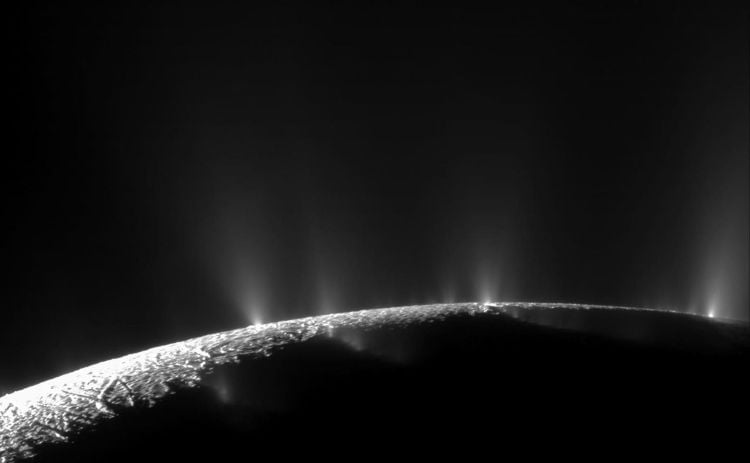What kinds of scientific instruments can be used to sample the plumes of Enceladus with the goal of identifying the ingredients for life as we know it? This is what a recent study presented at the56^th^Lunar and Planetary Science Conferencehopes to address as a team of international researchers investigated how the novel High Ice Flux Instrument (HIFI) could be the next-generation instrument used to sample the plumes of Enceladus while building off the groundbreaking findings from the NASA Cassini spacecraft's Cosmic Dust Analyzer (CDA). This study has the potential to help scientists and engineers develop new and efficient methodologies for finding life on Enceladus and throughout the solar system.
Here,Universe Todaydiscusses this incredible research with Dr. Sascha Kempf, who is an associate professor in the Laboratory for Atmospheric and Space Physics at the University of Colorado Boulder and lead author of the study, regarding the motivation behind the study, significant takeaways, making HIFI a reality, improving upon findings from NASA's Cassini mission, and what kinds of life he hypothesizes we could find within Enceladus. Therefore, what was the motivation behind the study?
"The design of the instrument is based on the requirements for an astrobiology mission," Dr. Kempf tells*Universe Today*. "We need an instrument that can identify tiny amounts of biomarkers like certain amino acids and fatty acids in the plume particle mass spectra. To do this, we need a mass resolution of about 1500 (the CDA mass resolution was 20). Also, because of the high impact rates during an Enceladus flyby, the instrument needs to have a very small, sensitive area. HIFI is meeting all these criteria."
For context, the CDA measured more than 1000 impacts per second using a sensitive area measuring 36 cm^2^(5.58 in^2^). Therefore, the researchers are proposing a smaller sensitive area to prevent overlapping measurements. The researchers also note the low resolution of current instruments in detecting life-bearing ingredients, with examples being carbon, hydrogen, nitrogen, oxygen, phosphorus, and sulfur (CHNOPS), but can also include key amino acids and organic molecules, with the hypothesized primary components being water and energy.
HIFI is a mass spectrometer, which is a well-known and widely used instrument across a myriad of scientific disciplines to identify specific molecules and particles and their masses. Samples for mass spectrometry can include solid, liquid, or gas, making it the ideal instrument for obtaining samples on space missions. Along with their myriads of Earth-based applications, mass spectrometry has been used on space missions as far back as the Viking program but has since been used on the Huygens probe that landed on Titan as part of the Cassini-Huygens mission. So, what are the most significant takeaways from this study and what are the next steps to make HIFI a reality?
"It's amazing how we can create such a sophisticated instrument," Dr. Kempf tells*Universe Today*. "My team actually built a similar instrument for NASA's Europa Clipper mission (the Surface Dust Analyzer - SUDA). SUDA has a mass resolution of about 200, which is already pretty impressive for a flight instrument. But HIFI is about 10 times better than SUDA in terms of resolution, which is considered a major challenge for such instruments. We're planning another round of performance tests, but this time, we'll be testing it with ice particles. We might ask NASA to fund a flight-like prototype. In any case we'll propose the instrument to NASA for consideration to be on the payload of a future ocean world mission."
As noted, HIFI builds off the incredible science conducted by Cassini's CDA instrument, which successfully identified trace amounts of organic and inorganic molecules that could have originated from hydrothermal vents at the bottom of Enceladus' vast liquid water ocean. Hydrothermal vents are found on Earth and host several species of single-celled and multicellular organisms, including chemosynthetic bacteria, giant tube worms, deep sea mussels, crabs, shrimp, clams, along with some fish species.
One of the pinnacle discoveries that Cassini made during its years-long mission at Saturn and its many moons was the geyser-like plumes at the south pole of Enceladus, potentially discharging liquid water and other substances from its subsurface ocean. Using its CDA, Cassini flew through the plumes on multiple occasions and measured thousands of dust-sized particles. With its other instruments, including its high-resolution cameras, Cassini successfully imaged and collected data about this mysterious moon which scientists continue to pour over today. But how will HIFI's findings improve upon Cassini's findings regarding identifying trace amounts of organic and inorganic molecules and what kinds of life does Dr. Kempf hypothesize we could find within Enceladus?
"Only high-fidelity instruments like HIFI can accurately identify the types and amounts of these species," Dr. Kempf tells*Universe Today*. "Cassini basically told us that there are quite a few organic molecules in Enceladus ice grains, but we still don't know much about them. The subsurface ocean is a prime spot in our solar system to find clues about life. If there's life in the ocean, we'll likely find a wide range of amino and fatty acids. The ratio of these acids will tell us if they came from biological activities."
How will HIFI help determine if Enceladus has the ingredients for life as we know it in the coming years and decades? Only time will tell, and this is why we science!
As always, keep doing science & keep looking up!
 Universe Today
Universe Today
